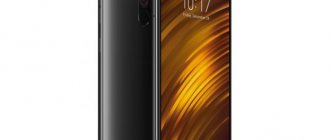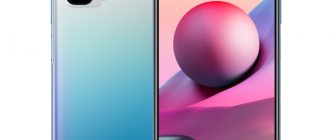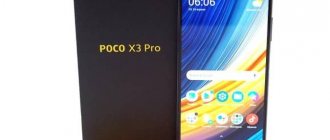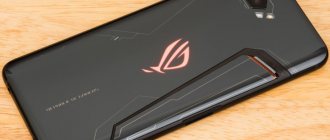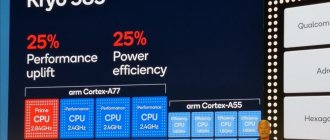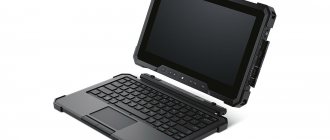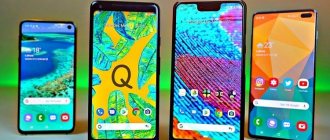On December 3, 2022, Qualcomm presented the flagship Snapdragon 865 chipset.
The process size remained identical to that of the Snapdragon 855/855+ - 7 nm. Cortex-A76 cores were replaced by Cortex-A77, replacing their predecessors in the first and second clusters, but maintaining similar frequencies: 2.84 GHz and 2.42 GHz. The energy-efficient cluster remains the same: four Cortex-A55s with a frequency of 1.8 GHz. According to the manufacturer, SD865 is 20% more powerful than SD855.
Graphics processing is handled by the Adreno 650 chip, which is 17% more productive than the Adreno 640. It supports API Vulkan 1.1, OpenGL ES 3.2, Opel CL 2.0 FP, DX12 and is capable of playing 8K video with virtual reality support. A special feature of the GPU was updates from OEM developers to optimize and speed up games. As of March 2022, the application for GPU updates has not been implemented.
The Spectra 480 processor, capable of processing images at a speed of 2 Gbps, is responsible for the photo capabilities. It provides support for a main camera with a resolution of up to 200 MP, one module compatible with ZSL technology up to 64 MP, and two sensors compatible with ZSL technology up to 25 MP. The chipset works in 5G networks provided that an additional Snapdragon X55 modem is connected. Support for Wi-Fi 6, Bluetooth 5.1, LPDDR5 RAM with a frequency of 2750 MHz is implemented. The system is compatible with displays up to 4K resolution at 60Hz. With QHD+, a refresh rate of 144 Hz is possible.
Smartphones powered by Snapdragon 865 are yet another “monster” with performance reserves for the next 2-3 years. We have collected all the officially announced and released smartphones based on this chipset, regardless of the market they are aimed at.
Samsung
By tradition, the flagship line from Samsung based on the Snapdragon 865 was released only for the Chinese and US markets. Like 2022, the 2020 series consists of three phones: Galaxy S20, S20 Plus and Galaxy S20 Ultra. Smartphones differ in screen diagonal, set of main camera modules and battery capacity. We wrote in detail about smartphones in two news stories: dedicated to the Galaxy S20 and S20 Plus, as well as the Galaxy S20 Ultra. Let's briefly talk about the key features of the gadgets.
The design of the devices is similar: a modest frame at the bottom, a selfie lens in a hole in the middle at the top. The screen resolution is the same (3200 x 1440), as is support for a 120 Hz refresh rate. The fingerprint scanner is located under the display. The main camera block was placed in the upper left corner. In the Ultra version, the main sensor has a resolution of 108 megapixels, and the 48 megapixel telephoto lens uses 10x optical and 100x digital zoom. According to trends, the 3.5 mm jack was abandoned in all models.
What to look for when buying Snapdragon smartphones
Processor line
Qualcomm divides processors into 4 lines, by the numbering of which you can determine which price segment the smartphone belongs to:
- Snapdragon 200 – ultra-budget series, not updated since 2015;
- Snapdragon 400 – includes budget solutions with weak computing cores;
- Snapdragon 600 is a mid-budget option for everyday use, without solving complex problems;
- Snapdragon 700 is a pre-flagship line that strikes a balance between performance and energy efficiency;
- Snapdragon 800 is a flagship single-chip, characterized by the presence of one large computing core.
Which Snapdragon is better for a smartphone can be determined by its number. For example, the SD 750G is faster than the SD732G, and the SD888 is superior to the SD865. There are also two prefixes that add to the SoC name:
- G – indicates the gaming affiliation of the model;
- Plus (+) – a processor with an overclocked core(s) compared to the regular version.
Powerful processors are more likely to overheat in games, which leads to a forced decrease in performance (throttling).
Graphics accelerator
Only Snapdragon uses Adreno GPU. It is considered the best among Android devices and is second only to the graphics installed in the Apple chipsets found in the iPhone. As with the names of processors, its serial number helps determine the best GPU. The most powerful as of October 2022 is Adreno 660, and the weakest is Adreno 610.
The list of supported APIs depends on the graphics core: Vulcan, DirectX, OpelGL and others. All this affects the final quality of graphics in games and the ability to emulate previous generations of consoles.
Xiaomi
Xiaomi is the second company after Samsung to introduce flagships powered by Snapdragon 865. Xiaomi Mi 10 and Mi 10 Pro received curved AMOLED displays with a diagonal of 6.67 inches, a refresh rate of 90 Hz and support for HDR10+ mode. A cooling system with 9 temperature sensors prevents the device from overheating.
The Xiaomi Mi 10 Pro has a more advanced set of camera sensors, including a telephoto lens with 5x optical zoom, a 4500 mAh battery with support for 50 W fast charging and up to 512 GB of internal UFS 3.0 memory. For more information about the characteristics and price of the Xiaomi Mi 10 line, see this link.
Qualcomm Snapdragon 865 – features, specifications
Qualcomm SDM865 Snapdragon 865 is the company's flagship mobile system on chip (SoC). The single-chip design is positioned as the latest high-performance platform for high-end smartphones and tablets.
The distinctive features of the chipset are:
- Supports the new X55 modem from Snapdragon, allowing the use of fifth-generation 5G networks.
- Cortex A77 processors, which are based on ARM architecture.
- Supports LPDDR5 RAM with frequencies up to 2750 MHz.
- Four energy-efficient cores based on Cortex-A55.
- Uses Samsung EUV (7 nm) process technology.
The new characteristics of the chipset have made it 25% more productive, while reducing power consumption. The Adreno 650 GPU is 15% faster than the previous 640 version and expands the capabilities of QHD+ displays.
Hexagon 698 has become 4 times faster, while consuming 35% less energy. Now familiar smartphones are capable of translating speech in real time, without even accessing online services.
In simple terms, the latest generation "dragon" has record-breaking performance, console-quality gaming graphics, improved AI and supernova photo/video capabilities.
Redmi
Redmi K30 Pro became the most affordable flagship at the end of March 2020, if we talk about the Standard Edition with 6 GB of LPPDR4X RAM and 128 GB of internal UFS 3.0 memory. The basic version of Redmi K30 Pro received 8 GB of fast LPPDR5 RAM and 128/256 GB of UFS 3.1 ROM. The developers did not stop and released the Redmi K30 Pro Zoom Edition with an advanced telephoto lens that can do 3x optical and 30x digital zoom. More about the features of each version, memory ratio and cooling system in our news dedicated to the announcement of the smartphone.
How to choose the best Snapdragon smartphone
Snapdragon is not just a processor, but a system on chip (SoC).
It contains computing and graphics cores, communication modems, banks of RAM and permanent memory. It depends on the SoC which smartphone can be assembled based on it, taking into account the maximum permissible screen resolution, its frequency, the amount of RAM/ROM, the size of the camera matrix and other things. Most of these parameters are not mentioned in the brief characteristics of the smartphone, so let’s go through the most basic ones.
Memory type
Affects system performance and data exchange speed. The standard for fast persistent memory is UFS. Flagships are equipped with UFS 3.0/3.1 memory, sub-flagships and mid-budget models are content with UFS 2.0/2.1. The most budget devices are equipped with eMMC 5.1, which is 2 times inferior to UFS in read/write speed.
The situation is similar with RAM. But in addition to the LPDDR4X/LPDDR5 type, the frequency measured in MHz is taken into account. The higher it is, the faster the RAM.
The video will tell you more about the differences between LPDDR4X and LPDDR5:
In order to save money, a chip with UFS 3.1 support is equipped with UFS 2.1 memory banks. The same can be done with RAM.
Interfaces
The versions and operating principle of wireless interfaces also depend on the installed chip. As an example, the sound through Bluetooth headphones will differ from one processor to another. As with memory, with declared support for BT 5.2, they can only use BT 5.0.
In smartphones for the Russian market, manufacturers disable support for 5G frequencies at the firmware level.
Cooling system
This is relevant for flagship chips, especially the Snapdragon 888. If a manufacturer skimps on heat dissipation options, the device starts to heat up even in basic tasks and reduces the frequency of the processor cores.
Gaming smartphones are equipped with coolers and housing ventilation holes, which increases the time a gamer can spend playing games.
Sony
The Japanese brand decided to move in its own direction and introduced the Sony Xperia 1 II smartphone, which is pronounced as - Xperia One Mark Two. It retained the feature of its predecessor - a “cinematic” display with an aspect ratio of 21:9. Its diagonal was 6.5 inches with a resolution of 3840 x 1644, which results in a very high pixel density of 643 ppi. The screen was supplemented with the Motion Blur Reduction function, designed to analyze the content on the display and eliminate delays between frames, ensuring smooth image transmission as on devices with support for a refresh rate of 90 Hz.
The filling is complemented by 8 GB of RAM and 256 GB of permanent memory. There is a slot for microSD cards up to 1 TB. The device is powered by a 4000 mAh battery. The case is protected from moisture and dust according to the IP65/IP68 standard. There is a 3.5 mm headphone jack, rare for flagships. On the back side there is a main camera unit of three 12 megapixel sensors, which includes: a main, wide-angle and telephoto lens. The device runs on Android 10.
Additionally, the Sony Xperia 1 II Pro smartphone was presented. Its specifications are identical to the base model, with the exception of 512 GB of internal memory. There is an HDMI port on the body of the device for connecting to a TV or camera. Another difference was the presence of 4 antennas for signal reception and support for mmWave and Sub-6 to expand the supported 5G frequencies.
realme
At the end of February, the Realme X50 Pro 5G smartphone was presented. Similar to other 2022 flagships, the device is compatible with LPPDR5 RAM (up to 12 GB) and UFS 3.0 permanent storage (up to 256 GB). The front panel is occupied by a SuperAMOLED display with a resolution of 2400 x 1080, a diagonal of 6.44 inches and an image refresh rate of 90 Hz. There are 2 selfie lenses, with a resolution of 32 and 8 megapixels. They are located in the oval cutout in the upper right corner.
The rear panel is occupied by a camera unit of 4 sensors: 64 MP main, 12 MP telephoto, 8 MP wide-angle/macro, 2 MP monochrome. Under the hood there is a 4200 mAh battery with support for SuperDart fast charging at 65 W - from 0 to 100% in 35 minutes. There is support for 5G networks, Wi-Fi 6 and Bluetooth 5.1. The fingerprint scanner is located under the screen. The device runs on Android 10 with realme UI shell.
Black Shark 3/3 Pro
The Xiaomi Black Shark sub-brand has equipped two gaming smartphones with the Snapdragon 865 chipset: Black Shark 3 and Black Shark 3 Pro. The refresh rate on devices stopped at 90 Hz, because the main advantage in the display sampling rate is as much as 270 Hz. The first device is equipped with a 6.67-inch FHD+ display, while its modification has a 7.1-inch Quad HD+ display. Sharing the duo is a triple rear camera setup. Xiaomi presented the gadgets with special firmware JoyUI 11 based on Android 10.
OPPO
Oppo Find X2 and Find X2 Pro are full-fledged flagship smartphones with almost frameless OLED displays with a diagonal of 6.7 inches, a resolution of 3168 x 1440 and a refresh rate of 120 Hz. The screen is covered with protective glass Corning Gorilla Glass 6, the selfie camera is located in the hole on the left. The powerful Snapdragon 865 is complemented by 12 GB of LPDDR5 RAM and an internal storage of 256/512 GB of UFS 3.0 standard.
The main difference between the versions is hidden in the set of cameras; OPPO Find X2 Pro has a better main sensor and periscope telephoto lens. The Pro body is protected from dust and moisture according to the IP68 standard. Both versions are complemented by support for 65W fast charging. The basic version is available with glass or ceramics, the older version has a leather cover.
OPPO has unveiled a flagship smartphone aimed at gamers. To achieve this, Reno Ace 2 has an advanced cooling system with a graphite substrate and a T-shaped copper plate. This solution should promote optimal heat dissipation. At the same time, the back cover is made of glass, which is due to support for fast wireless charging with a power of 40 W. It is fueled by a 4,000mAh battery that also supports 65W wired fast charging.
On the front there is a 6.55-inch OLED display with a built-in fingerprint scanner, a dot cutout for the selfie camera on the top left, an image refresh rate of 90 Hz and a 180 Hz touch layer. The top version received 12 GB of LPDDR5 RAM, 128/256 GB of built-in storage of the UFS 3.0 standard. There are user-facing stereo speakers, 4 camera lenses on the back, but no NFC.
Rating of Snapdragon smartphones for 2022
1. The best flagship smartphone with Snapdragon OnePlus 9 Pro
Compare prices
Why we liked it: the smartphone is equipped with a top-end Snapdragon 888, which instantly processes pictures from the 48 MP main camera and supports a frequency of 120 Hz on a large screen. The short battery life is compensated by support for 65W fast charging. Editor's Rating:
Main characteristics:
- Screen: AMOLED, 6.7-inch, 3216 x 1440, 120 Hz, 526 ppi
- Processor: Snapdragon 888, Adreno 660 graphics
- Battery: 4500 mAh
- Main camera: 48 MP + 50 MP + 8 MP + 2 MP
- Memory options: 8/128 GB, 8/256 GB, 12/256 GB
Performance
The model is equipped with the top-end Snapdragon 888 for Android smartphones in 2022. Only its upcoming modification with the Plus prefix and the Apple A15 single-chip system are more powerful than this chip. The already powerful device is complemented by 8 or 12 GB of RAM. The 4500 mAh battery can withstand about 4 hours of screen operation at 120 Hz. This drawback is mitigated by fast charging at 65 W, which restores the battery in 40–60 minutes.
Display
The AMOLED matrix is made using LPTO technology with rich, bright color reproduction. The maximum resolution is 3216 x 1440 - on the 6.7-inch display, any image looks as clear as possible. The fingerprint sensor located under the screen recognizes your fingerprint on the first try.
Design and interfaces
OnePlus 9 Pro is a full-fledged flagship, covered with glass panels on the front and back. An aluminum frame separates the front and back parts. The frames around the display are almost symmetrical, and the only cutouts are a hole for the 16 MP front camera. Music and other audio is played in stereo.
Among the wireless interfaces, there are Wi-Fi 6, Bluetooth 5.2 and NFC, which are advanced for 2021. The headphone jack was naturally abandoned.
Cameras
Photo capabilities are provided by 4 cameras with a 48 MP main camera, a 50 MP ultra-wide-angle lens, an 8 MP telephoto lens and a 2 MP black-and-white module. Collaboration with the Swedish manufacturer of medium format cameras Hasselblad has raised the quality of images to the level of flagships from Samsung and Apple.
pros
- flagship chip;
- very fast charging;
- 4K display resolution;
- high-quality stereo sound;
- premium body materials.
Minuses
- discharges quickly;
- It heats up in games, when shooting photos/videos.
2. The best compact smartphone on Snapdragon Xiaomi Mi 11 Lite
Compare prices
Why we liked it: a compact smartphone by modern standards with minimal bezels around the display and an excellent camera for the price segment. The package includes a 33W power supply for fast charging. Editor's Rating:
Main characteristics:
- Screen: AMOLED, 6.55-inch, 2400 x 1080, 90 Hz, 402 ppi
- Processor: Snapdragon 732G, Adreno 618 graphics
- Battery: 4250 mAh
- Main camera: 64 MP + 8 MP + 5 MP
- Memory options: 6/64 GB, 6/128 GB, 8/128 GB
Performance
The basis of the smartphone is the SD732G. In combination with Adreno 618 and 6/8 GB of RAM, the CPU power is enough to run demanding games at medium graphics settings and quickly process pictures using a 64 megapixel lens. The chipset is energy efficient and under mixed loads drains the 4250 mAh battery in about 8.5 hours. The experience of using it is spoiled by the imperfect MIUI 12: it freezes periodically, the phone loses the network, and NFC does not always work.
Display
The smartphone's AMOLED matrix displays bright and rich colors, which it displays on a 6.55-inch display with a resolution of 2400 x 1080. In the settings, you can enable a 90 Hz refresh rate for smooth operation of the interface. There is no DC Dimming function, so PWM is noticeable at minimum brightness settings.
Design and interfaces
The front and back covers of Xiaomi Mi 11 Lite are made of glass. The back side is glossy, so it quickly collects fingerprints. The fingerprint scanner is built into the power button.
Due to the case thickness of only 6.81 mm, the manufacturer refused to add a 3.5 mm headphone jack. Their shortcomings are compensated by high-quality stereo speakers and energy-efficient Bluetooth 5.1 for lovers of wireless headsets. There is also NFC for contactless payment and an infrared port for controlling equipment.
Cameras
The main unit consists of three modules: 64 MP main, 8 MP wide-angle and 5 MP macro. 16 MP front lens. The bet is placed on the main and macro modules - the frames shot on them turn out to be detailed and with natural color reproduction. Stabilization is only electronic.
pros
- compactness;
- performance;
- pictures taken with the main camera;
- Power supply with fast charging included.
Minuses
- problems with the firmware.
Best Affordable Snapdragon Flagship Samsung Galaxy S20 FE (SM-G780G)
Compare prices
Why we liked it: Samsung's affordable flagship with a juicy screen, great cameras, and a powerful processor. The minimalistic design is complemented by 6 body colors to suit every taste. Editor's Rating:
Main characteristics:
- Screen: Super AMOLED, 6.5 inches, 2400 x 1080, 120 Hz, 405 ppi
- Processor: Snapdragon 865, Adreno 650 graphics
- Battery: 4500 mAh
- Main camera: 12 MP + 12 MP + 8 MP
- Memory options: 6/128 GB, 8/256 GB
Performance
A smartphone with a Snapdragon 865 processor is the flagship of 2022. The chipset supports 5G networks, runs any games at maximum graphics settings and can easily handle 2-3 heavy applications with both 6 and 8 GB of RAM. However, even in everyday tasks, the smartphone body becomes noticeably hot.
The battery life of the 4500 mAh battery depends on the display refresh rate: at 60 Hz it lasts about 7–8 hours, at 120 Hz the battery life drops to 4–5 hours. The smartphone supports wireless charging and fast wired charging at 25 W, but a 15 W unit is included in the package.
Display
The Samsung Galaxy S20 FE is equipped with calibrated Super AMOLED matrices with clear color reproduction and bright images. Unlike Xiaomi smartphones, DC Dimming is installed here to reduce screen flickering, and the AoD function (shows the time and date on the screen off) works constantly instead of 10 seconds for competitors. The display dimensions are standard: resolution 2400 x 1080, diagonal 6.5 inches.
The screen has a dot cutout for a 32 MP selfie camera and an area with an under-screen fingerprint scanner. The latter is unstable, so you have to save the print 3-4 times.
Design and interfaces
The budget nature of the flagship is revealed by its back cover, made of plastic instead of glass, which is classic for the segment. The case is protected according to the IP68 standard - the smartphone can spend up to 30 minutes in water at a depth of 1.5 meters and remain in working condition.
Following trends, the manufacturer removed the 3.5 mm headphone jack from the model and saved on Bluetooth by installing version 5.0. An NFC chip is present, as is support for Wi-Fi 6 (802.11ax).
Cameras
Instead of chasing resolution, the Samsung Galaxy S20 FE installed a 12 MP main and wide-angle lens and an 8 MP telephoto lens. Pictures taken with any module turn out to be detailed even at night without using the night shooting mode. An additional advantage is the presence of optical image stabilization - when shooting, the image is transmitted smoothly, without shaking.
pros
- design;
- CPU;
- juicy screen;
- main camera lens.
Minuses
- complete charging at 15 W;
- It heats up even under light loads.
Best budget smartphone with Snapdragon Xiaomi Redmi 9T NFC
Compare prices
Why we liked it: a smartphone from the budget segment with a capacious 6000 mAh battery, NFC and Full HD display resolution. The kit includes a protective case and screen film. Editor's Rating:
Main characteristics:
- Screen: IPS, 6.5 inches, 2340 x 1080, 60 Hz, 395 ppi
- Processor: Snapdragon 662, Adreno 610 graphics
- Battery: 6000 mAh
- Main camera: 48 MP + 8 MP + 2 MP + 2 MP
- Memory options: 4/64 GB, 4/128 GB
Performance
The smartphone with Snapdragon 662 is a chipset from the mid-budget series. This chip is designed for surfing the Internet, browsing social networks and running games at minimum graphics settings. Considering the low power, the smartphone's 6000 mAh battery can withstand up to 10 hours of operation under stable load: watching videos, mobile Internet turned on, gaming sessions for 2–3 hours. From a complete 18 W charge, the battery is restored in 2.5 hours.
Display
The screen has the same characteristics as flagships: 2340 x 1080 resolution, 6.5-inch diagonal, Corning Gorilla Glass 3 for scratch protection. An IPS matrix with a low brightness level is installed, which is why information becomes almost unreadable in the sun.
Design and interfaces
The Xiaomi Redmi 9T NFC body is made entirely of high-quality plastic. The included case is responsible for its safety. Nice features include a USB Type-C connector, stereo speakers, an NFC chip, a 3.5 mm headphone jack and an infrared port. All advantages are spoiled by a quiet speaker and a lot of advertising applications pre-installed in MIUI. The fingerprint scanner is combined with the lock key.
Cameras
The smartphone has 4 cameras on the back side. The main 48 megapixel module shoots at a level decent for a budget employee in natural or sufficient artificial lighting. At night there are noises. An ultra-wide-angle and 2 auxiliary sensors are installed for show. The 8 MP selfie camera is designed for video calls in instant messengers.
pros
- NFC;
- autonomy;
- available interfaces;
- high resolution display.
Minuses
- brightness reserve;
- speaker volume.
5. Best performance among mid-budget models Xiaomi POCO X3 Pro
Compare prices
Why we liked it: Powerful SD860 processor and 120Hz display for little money. A capacious 5160 mAh battery complements the included 33 W power supply. Editor's Rating:
Main characteristics:
- Screen: IPS, 6.67 inches, 2400 x 1080, 120 Hz, 395 ppi
- Processor: Snapdragon 860, Adreno 640 graphics
- Battery: 5160 mAh
- Main camera: 48 MP + 8 MP + 2 MP + 2 MP
- Memory options: 6/128 GB, 8/256 GB
Performance
The Snapdragon 860 installed in the smartphone is an improved version of the flagship SD855+ chip, released in 2022. The power reserve and 6/8 GB of RAM are enough to solve any user tasks: from games to processing videos in a video editor. However, regardless of the usage scenario, the case heats up. With average but stable loads, the smartphone battery lasts for 1–1.5 days of use. The battery is charged to 100% in 2–2.5 hours.
Display
The manufacturer used an average quality IPS matrix with a maximum refresh rate of 120 Hz. The screen size is a huge 6.67 inches with a resolution of 2400 x 1080, while maintaining a comfortable pixel density of 395 - the image is clear, without “grain”.
Design and interfaces
The body of Xiaomi POCO X3 Pro is made of plastic, which begins to rattle when playing music through the built-in stereo speakers. Considering the huge dimensions of the device (165.3 x 76.8 x 9.4 mm), the developers left a jack for wired headphones. The model is not lightweight and weighs 215g, which can make it awkward to use.
Cameras
Unlike its direct analogue in the form of POCO X3 NFC, the Pro version saved money on camera models by installing a weaker 48 MP main matrix, an 8 MP wide-angle module and two additional 2 MP modules. The quality of the images depends heavily on the lighting and is often of an average level; detail and color rendition suffer.
pros
- CPU;
- battery and fast charging;
- Accessories from the X3 NFC model are suitable;
- screen with full support for 120 Hz.
Minuses
- warms up;
- low quality of pictures.
6. Best budget camera phone with Snapdragon Xiaomi Redmi Note 10 Pro
Compare prices
Why we liked it: the maximum content for its segment with an excellent 108 MP main camera. Bright 1200 nits screen with support for 120Hz refresh rate. Editor's Rating:
Main characteristics:
- Screen: AMOLED, 6.67 inches, 2400 x 1080, 120 Hz, 395 ppi
- Processor: Snapdragon 732G, Adreno 618 graphics
- Battery: 5020 mAh
- Main camera: 108 MP + 8 MP + 5 MP + 2 MP
- Memory options: 6/64 GB, 6/128 GB, 8/128 GB
Performance
The energy-efficient Snapdragon 732G is suitable for gaming at medium graphics settings, stable OS operation with moderate power consumption. The 5020 mAh battery lasts up to 10 hours and then charges to 100% in 60-80 minutes with 33W fast charging.
Problems are caused by the crude MIUI 12.5 firmware with numerous flaws and an ultrasonic proximity sensor that does not respond to approaching objects. This results in the display not always turning off during a call or when the on-screen buttons are accidentally pressed.
Display
An AMOLED matrix from Samsung is installed with maximum viewing angles, rich images and support for a frequency of 120 Hz. A separate plus is the brightness reserve - 1200 nits ensure a readable picture even on a sunny day. Of the cutouts, there is only a pinhole for the selfie module.
Design and interfaces
The smartphone has a glass case with a glossy back cover that attracts debris and fingerprints; the included case changes position. The thin body and large main lens resulted in a noticeably protruding camera platform.
The sound in the device is provided by stereo speakers, a headphone jack and Bluetooth 5.1. We haven’t forgotten about NFC for contactless payment and an infrared port for controlling equipment.
Cameras
The 108 MP main lens takes excellent quality pictures, capturing as much information as possible from the photo. The disadvantage is the lack of optical stabilization and the long time it takes to process a full-size image. The rest of the lenses are budget, the only one that stands out is the honest 5 MP macro lens.
pros
- camera;
- display;
- autonomy;
- set of interfaces.
Minuses
- proximity sensor.
7. The best sub-flagship smartphone on Snapdragon Xiaomi POCO F3
Compare prices
Why we liked it: Instead of the hot Snapdragon 888, the SD870 is installed, which generates less heat. DC Dimming is pre-installed to reduce screen flicker. Editor's Rating:
Main characteristics:
- Screen: AMOLED, 6.67-inch, 2400 x 1080, 120 Hz, 395 ppi
- Processor: Snapdragon 870, Adreno 650 graphics
- Battery: 4520 mAh
- Main camera: 48 MP + 8 MP + 5 MP
- Memory options: 6/128 GB, 8/256 GB
Performance
Similar to other flagships, the Snapdragon 870 provides ultra graphics settings in games and stable system operation in combination with 6/8 GB of RAM. Battery consumption is average and the 4520 mAh battery lasts for 6-7 hours of use. The kit includes a 33 W power supply that replenishes the battery to 100% in less than 1.5 hours.
Display
An AMOLED matrix from Samsung with precise color calibration is installed. The maximum brightness level is 1300 nits – information on the screen remains readable even in the sun. There is pre-installed DC Dimming, support for a frequency of 120 Hz. The image at 6.67 inches and with a resolution of 2400 x 1080 is clear.
Design and interfaces
The body is covered with glass panels on both sides. The cutout for the selfie lens is at the top in the middle, and there is stereo sound. A miscalculation was the use of an ultrasonic proximity sensor - during a conversation it does not turn off the screen, which is why random taps on the display occur. There are problems with the firmware, which results in slowdowns and crashes.
There is no headphone jack. Support for Bluetooth 5.1 is implemented, there is an NFC chip.
Cameras
Similarly with POCO X3 Pro, F3 saved on cameras. They do not reach the flagship level, which is noticeable in the detail of the images. Image stabilization is only electronic.
pros
- screen;
- power reserve;
- premium design;
- battery life.
Minuses
- camera;
- proximity sensor.
8. The best mid-budget smartphone from Samsung with Snapdragon Samsung Galaxy A52
Compare prices
Why we liked it: an analogue of the Chinese Redmi Note 10 Pro with a high-quality camera, optical stabilization and IP67 protection. There is a jack left for wired headphones. Editor's Rating:
Main characteristics:
- Screen: Super AMOLED, 6.5 inches, 2400 x 1080, 90 Hz, 405 ppi
- Processor: Snapdragon 720G, Adreno 618 graphics
- Battery: 4500 mAh
- Main camera: 64 MP + 12 MP + 5 MP + 5 MP
- Memory options: 4/128 GB, 8/256 GB
Performance
The smartphone is powered by Snapdragon 720G – the chip is a weaker variation of the SD732G. The lack of power is especially noticeable in the version with 4 GB of RAM: long processing of images, freezing of the OS, forced reboot. The 4500 mAh battery holds a charge for up to 6 hours of active screen time; only a 15 W base power supply is included, although the device supports 25 W charging.
Display
The manufacturer installed a proprietary Super AMOLED matrix on the device with traditionally saturated colors and a high brightness margin. A fingerprint scanner is placed under the 6.5-inch screen. The 32MP selfie camera is housed in a dot cutout at the top.
Design and interfaces
The body is plastic, with a protruding rear camera block. Wireless interfaces in the form of NFC, Wi-Fi 6 and Bluetooth 5.0 are complemented by a 3.5 mm audio output. Stereo speakers are present, as is protection from water and dust according to the IP67 standard - the smartphone can withstand a 30-minute immersion in water to a depth of 1 meter.
Cameras
The rear camera block consists of 4 lenses, where the focus is on the main 64 MP module. Pictures taken with it are obtained with high detail and accurate color rendition in natural light. An additional advantage is optical stabilization. Other cameras shoot much worse and are needed more for marketing promotion.
pros
- design;
- display;
- moisture protection.
Minuses
- amount of RAM in the basic version;
- insufficiently powerful processor.
ZTE
ZTE Axon 10s Pro was announced back in December 2022, the characteristics were announced on February 6, 2022, they wanted to show the device at the MWC exhibition, but it was canceled due to the threat of coronavirus. The design of the device follows the trends: a curved 6.47-inch AMOLED display with a resolution of 2340 x 1080, a built-in fingerprint sensor and a drop-shaped cutout for a 20 MP selfie module. The main camera unit consists of 3 sensors: 48 MP main, 20 MP wide-angle and 8 MP telephoto.
In addition to a powerful processor, the smartphone offers up to 12 GB of LPPDR5 RAM and UFS 3.0 storage up to 256 GB. The 4000 mAh battery is compatible with QC4+ fast charging. Other features include support for DTX:X Ultra surround sound and stereo speakers. ZTE Axon 10s Pro does not have a memory card slot and a 3.5 mm jack. The OS is Android 9.0 Pie.
Sharp
The presentation of Sharp Aquos R5G with support for 5th generation networks took place only for the Japanese market. The front panel of the device is dedicated to an IGZO display with a resolution of 3168 x 1440, a 6.5-inch diagonal and a refresh rate of 120 Hz. At the top there is a U-shaped cutout for a 16 MP selfie camera, at the bottom there is a “Home” button with an integrated fingerprint scanner.
The developers offer up to 12 GB of RAM and up to 256 GB of internal memory. Under the cover there is a battery with a capacity of 3730 mAh, the case is protected according to the IP68 standard. The camera unit consists of 3 modules: a 12-megapixel main lens, a 12-megapixel telephoto lens, a 48-megapixel wide-angle sensor and a 0.3-megapixel depth sensor.


